Karl Shuker's Blog, page 66
April 15, 2012
A SEA SNAIL WITH ANTLERS...AND PAWS!
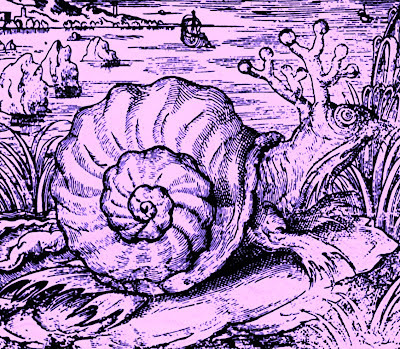 The Sarmatian Sea's antlered, paw-footed mega-snail, as depicted in Paré's book (colourised version)
The Sarmatian Sea's antlered, paw-footed mega-snail, as depicted in Paré's book (colourised version)Just when you think that the world, particularly the cryptozoological world, couldn't possibly get any stranger...
Roll up, roll up, ladies and gentlemen – I am proud to present before you, all the way from the Sarmatian Sea, the one and only giant monster sea snail with antlers, and paws!
It's amazing what you find when looking for something completely different. Browsing through some early books recently in search of some relevant illustrations appertaining to mystery cats for my forthcoming second book on magical, mythological, and mysterious felids of many forms, I chanced upon the following astonishing beast from a medieval bestiary cum medical encyclopaedia entitled On Monsters and Marvels, written by Ambroise Paré, a 16th-Century French surgeon.
Citing as his source of information the twentieth volume of Cosmography - which had been authored by one of his contemporaries, André de Thévet (1516-1590), a French Franciscan priest who was also a celebrated writer, explorer, and cosmographer - Paré reported that the Sarmatian or Eastern Germanic Sea (both are early names for the Baltic Sea) is home to a truly monstrous species of sea snail.
As thick as a wine cask, this singular and very sizeable creature is instantly distinguished from all other such molluscs by virtue of its pair of deer-like antlers. These decidedly unsnail-like accoutrements are borne upon the upper region of its head, and at the tip of each branch on each antler is a small, round, lustrous bulb resembling a fine pearl. By contrast, this snail's eyes, which in less exotic gastropods can be found at the tips of a pair of optic tentacles, are laterally sited on its head, just like those of many vertebrates, and glow brightly like candles.
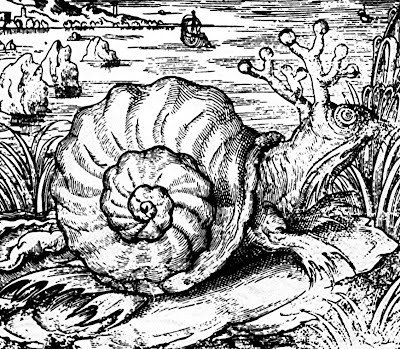 Paré's tale of a very strange snail! Has a creature like this ever truly inhabited the Baltic Sea?
Paré's tale of a very strange snail! Has a creature like this ever truly inhabited the Baltic Sea?Equally unexpected was Paré's claim that this very odd creature sports a roundish nose reminiscent of a cat's, complete with whisker-like hair all around it, plus a wide slit-like mouth beneath which hangs a fleshy projection of hideous appearance.
And as if antlers and a feline nose are not sufficiently bizarre characteristics for a sea snail (or, indeed, any other type of snail) to boast, eschewing the usual monopodial mode of locomotion common to normal gastropods this extraordinary marine mollusc possesses four fully-differentiated limbs, each with its own wide, hooked paw. It also sports a fairly lengthy tail, bearing a varicoloured tigerine pattern. Moreover, the image accompanying this morphological description in Paré's book shows the Sarmatian Sea's antlered mega-snail to bear a very large and sturdy, heavily annulated, whorled shell upon its back.
This remarkable creature apparently spends much of its time out at high sea on account of its timid nature, but is sufficiently amphibious to be able to venture forth onto the seashore during fine weather in order to graze upon any marine plant life present there. An edible species itself, its flesh is said to be very delicate and tasty to eat, and its blood reputedly has medical properties, ameliorating sufferers afflicted with leprosy.
Needless to say, no snail corresponding with the description communicated in turn by Paré from Thévet's work is known to modern-day science. So could the giant antlered snail of the Sarmatian Sea be as mythical as the web-footed camphurch unicorn, the mer-folk, the winged unipodal humanoids, and certain other unquestionably fabulous entities also documented by these authors, or is it merely a somewhat distorted description of some bona fide animal?
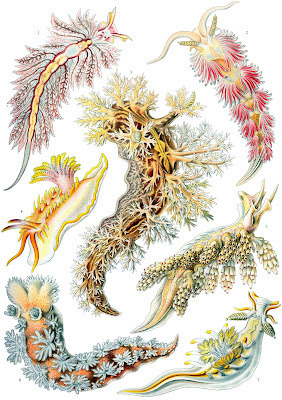 A beautiful colour plate from a 1904 tome by Ernst Haeckel depicting a varied selection of spectacular nudibranchs
A beautiful colour plate from a 1904 tome by Ernst Haeckel depicting a varied selection of spectacular nudibranchsReading it through, I was reminded somewhat of the nudibranchs or sea slugs, many of which are extremely flamboyant in appearance, with all manner of ornate, plume-like embellishments known as cerata arising dorsally and laterally from their body, which may conceivably explain the 'limbs' and 'paws' reported for this creature. Nudibranchs also have a pair of long cephalic (head-borne) tentacles, and if a species existed whose tentacles bore projections they may resemble antlers. Moreover, the two eyes of nudibranchs are sited directly on their body, just behind the head, not on optic tentacles like those of snails, so a pair of laterally sited eyes would not be impossible. And nudibranchs are well documented from the Baltic Sea.
However, such an identity is instantly wrecked by the Sarmatian antlered snail's hefty shell, because nudibranchs are shell-less. In addition, all known nudibranchs are carnivorous, not herbivorous. And even the largest known nudibranchs do not exceed 2 ft long – a far cry from any gastropod as thick as a wine cask.
So what is the likeliest identity of this mystery mollusc? Might it possibly have been an unknown species that became extinct before modern-day science was ever able to confirm its reality and add it to the zoological catalogue of formally-recognised life-forms? Or could such an incredible creature as this never have been anything more than a wholly imaginary beast confined to the pages of early travelogues and compendia of monsters? To be, or not to be? That, indeed, is the question.
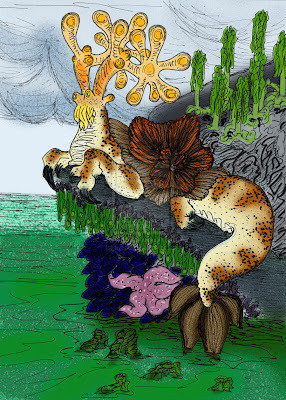 A splendid, wholly original representation of the Sarmatian Sea's antlered mystery snail by Avancna (click
here
to visit Avancna's page on DeviantArt's website)
A splendid, wholly original representation of the Sarmatian Sea's antlered mystery snail by Avancna (click
here
to visit Avancna's page on DeviantArt's website)
Published on April 15, 2012 16:55
April 8, 2012
ZEBRA CROSSINGS - THE DAY I MET A ZORSE, A ZONKEY, AND A ZEEDONK!
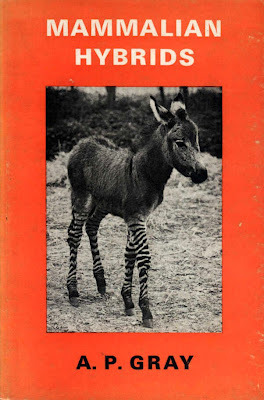 Mammalian Hybrids, 2nd edition (1971) – its front cover depicts a young zebronkey at Colchester Zoo
Mammalian Hybrids, 2nd edition (1971) – its front cover depicts a young zebronkey at Colchester ZooBack in the early 1970s, when still a child, I read with great interest that Colchester Zoo in Essex had on display a remarkable creature known as a zonkey or zebronkey – a hybrid of zebra and donkey. Sadly, however, even though my parents took me to numerous zoos all over Britain during my childhood and teenage years, somehow we never did visit Colchester's, and as there were no such hybrids anywhere else in the country at that time, this meant that I never did see one of these fascinating animals.
All of that changed a mere 40-odd years later, however, when, just over a week ago, on Saturday 31 March 2012, to be exact, I had the great pleasure of visiting Donkey Rescue UK, based just outside Bridgnorth in Shropshire. For here, not only did I finally see a zonkey, I was also fortunate enough to see a zeedonk and a zorse.
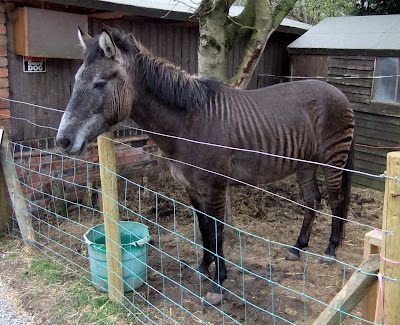 Zulu, Donkey Rescue UK's beautiful zorse (Dr Karl Shuker)
Zulu, Donkey Rescue UK's beautiful zorse (Dr Karl Shuker)But what exactly are zorses, zonkeys, and zeedonks, not to mention zebroids, zebryls, zeehorses, zebrulas, zebrasses, zebrets, zonies, hebras, donkras, quorses, and a host of other equally strange-sounding equids on record, and how do they (or do they) all differ from one another? Let me now explain – or try to!
The terminology for zebra Equus spp. x domestic horse E. caballus, zebra Equus spp. x domestic donkey E. asinus, and the respective reciprocal crosses is nothing if not confusing, to say the very least. For instance: in the past, 'zebroid' was usually applied to zebra x horse crossbreeds in either direction, but is nowadays most commonly used as a generic term for all equid hybrids featuring zebras.
'Zorse' is the term most widely applied to any ♂zebra x ♀horse hybrid (other terms in use for this hybrid type are 'zebrula', 'zebrule', 'zebryl', 'zeehorse', 'zebra mule', and 'golden mule'). The rarer reciprocal cross (♂horse x ♀zebra) is known as a hebra, horbra, zebrinny, or zebret. And the offspring of a ♂zebra and a ♀pony is a zony.
The terms 'zonkey' and 'zeedonk' can be found commonly in use as generic terms for all zebra x donkey hybrids. Moreover, 'zonkey' is also applied more specifically as a term for ♂zebra x ♀donkey hybrids. Other terms for these include 'zebronkey' (aka 'zebonkey'), and 'zebrass'. Similarly, 'zeedonk' is also applied more specifically to the much less common reciprocal cross; another term for this latter hybrid is 'donkra'.
ZULU'S A ZORSE, OF COURSE, OF COURSE!
The first of the three zebroids that I encountered at Donkey Rescue UK was a beautiful zorse, called Zulu. Almost five years old, Zulu is currently the only zorse in the UK, and came here from the USA. His father is a Grant's zebra Equus quagga boehmi (a subspecies of the plains zebra) and his mother is a grey Arab horse. As can be seen in my photos, his black stripes overlay his coat's brown background colouration, and although this will fade to grey in years to come, his stripes will remain black. Apparently his senses are more acute than those of a horse.
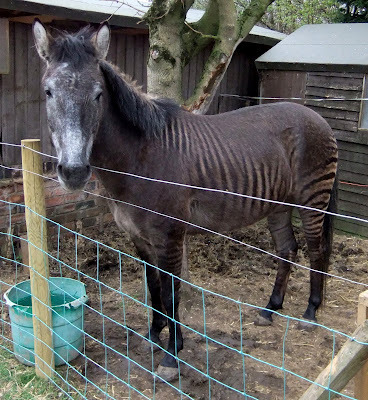 Zulu the zorse at Donkey Rescue UK (Dr Karl Shuker)
Zulu the zorse at Donkey Rescue UK (Dr Karl Shuker)Zorses are by no means a modern-day creation. On the contrary, they were being bred as long ago as the 19th Century. One notable example from that period was a very handsome male specimen called Romulus, as seen here when photographed as a one-year-old in 1899.
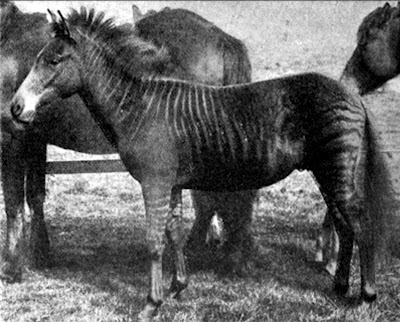 Romulus, a zorse from 1899
Romulus, a zorse from 1899Moreover, zonies bred by mating Chapman's zebras E. q. chapmani with ponies were utilised by the Boers during the South African Wars (1879-1915) as transport animals, particularly for hauling heavy guns. One of these zonies, captured by British forces, was presented by Lord Kitchener to King Edward VII, which the king in turn placed in the Zoological Society of London's care on 19 July 1902, by which time it was two years old. The following illustration of this zony appeared in the Society's Proceedings for 1903:
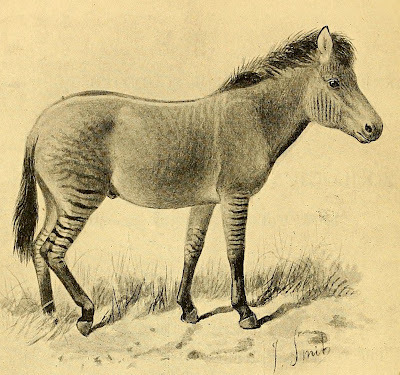 The zony given to the Zoological Society of London by Edward VII
The zony given to the Zoological Society of London by Edward VIIEven so, zorses didn't attract widespread public attention until the late 1940s, following the successful breeding of Grevy's zebra E. grevyi x horse hybrids on the farm of African explorer Raymond Hook, situated near to Nanyuki in Kenya. It all began when Hook captured an 18-month-old male Grevy's zebra in 1944, and introduced it to his farm's herd of horses. The young zebra was soon adopted by one of the herd's mares acting as a foster mother, it grew to adulthood, and from the age of six until its retirement 14 years later it regularly mated with various of the mares to yield a continuing supply of Grevy's zorses. In 1955, the first of these (born in 1949) was sold to an exhibition in Florida called 'Africa USA', where it received notable publicity, so afterwards Hook sold many more Grevy's zorses to zoos and parks worldwide.
In general appearance, a Grevy's zorse possesses its mother's background coat colouration. However, its father's characteristic fine striping is readily apparent upon its face and legs, and to varying extents upon its body too, running down from the dark line along its spine almost as far as its pale underparts.
In contrast, a Grevy's hebra - bred from the reciprocal cross ((♂horse x ♀Grevy's zebra) - exhibits a less pronounced degree of striping.
Zorses and hebras bred from other zebra species have comparable appearances to their respective Grevy's-bred counterparts, although their limbs actually possess more stripes than those of their pure-bred zebra parent if they have been sired by a stallion belonging to any of the subspecies of the plains zebra E. quagga [=burchelli].
If a patterned horse, such as a roan, Apaloosa, pinto, piebald, or skewbald, is mated with a zebra, the hybrid offspring possesses stripes, but usually only on the non-white areas. If the horse was chestnut or bay, some exceptionally beautiful hybrids known as golden zorses or golden zebras can result.
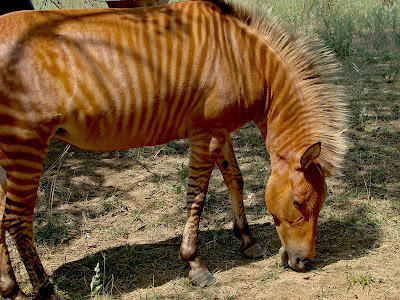 A golden zorse – the exquisite progeny of a zebra and a chestnut/bay horse
A golden zorse – the exquisite progeny of a zebra and a chestnut/bay horsePerhaps the most celebrated hebra on account of its extremely unusual, eyecatching coat patterning is Eclyse, born during 2007 at a safari park at Schloss Holte Stukenbrock, Germany, to a ♂horse and a ♀zebra. Her father, a tobiano pinto, has sizeable areas of white coat colouration, and as these result from the expression of a dominant depigmentation gene, Eclyse inherited this same gene and bears comparable white areas on her own coat. As a result, the striping that she inherited from her zebra mother is confined to her coat's pigmented (i.e. non-depigmented) areas, thus creating her exceptional degree of non-continuous patterning.
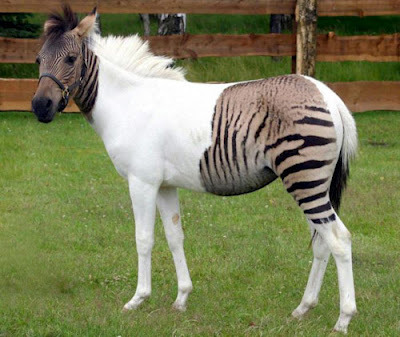 Eclyse, probably the most eyecatching zebra x horse hybrid ever seen
Eclyse, probably the most eyecatching zebra x horse hybrid ever seenGrevy's zorses and hebras are invariably sterile, for whereas the horse possesses 64 chromosomes (32 pairs), Grevy's zebra only has 46 chromosomes (23 pairs), with the resulting hybrid possessing 55 chromosomes (27 pairs plus a single unpaired chromosome). The differences in chromosome numbers are also marked between the horse and the other two zebra species. Even so, there is some evidence to suggest that fertile female hybrids bred from horses and Chapman's zebras are occasionally fertile.
In addition to selling Grevy's zorses to zoos, Raymond Hook used some in place of mules (♂donkey x ♀horse hybrids) as pack animals on his farm, and he discovered not only that they were blessed with more agreeable temperaments than pure-bred Grevy's zebras but also that they worked as efficiently as mules. Similarly, zorses bred from Chapman's zebras and again used for pack work in their native lands have proven to be strong, active, and intelligent, as well as being more resistant than horses to sleeping sickness spread by tsetse flies.
In view of such commendable attributes, it is quite likely that in the future zorses will eventually become recognised more for their practical usefulness than for their current popularity as engaging zoo and park exhibits. And indeed, they are currently being bred in Africa for use in trekking on Mount Kenya.
ZAMBI THE ZONKEY
In recent times, the zorse type most frequently displayed in zoos is probably the version bred from Grant's zebra, such as Zulu. Yet even this is far less often on show than zonkeys or zebronkeys, i.e. hybrids bred from ♂zebras and ♀donkeys – of which Zambi at Donkey Rescue UK is a delightful example. Others include the zebra x donkey hybrids bred at Colchester Zoo from the early 1970s onwards, the last of which, a female called Shadow, died at the ripe old age of 34 on 3 April 2009.
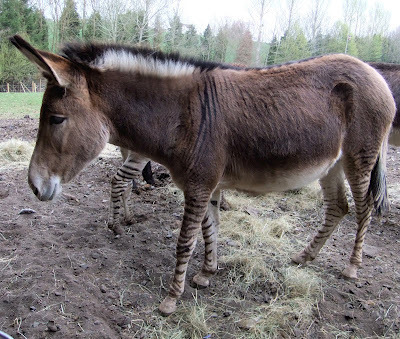 Zambi the zonkey at Donkey Rescue UK (Dr Karl Shuker)
Zambi the zonkey at Donkey Rescue UK (Dr Karl Shuker)Arriving here in December 2011, Zambi has a Grevy's zebra as her father and a Giant Mammoth Jackston donkey as her mother. And as the latter donkey breed is known for its great size, it is possible that when fully grown, Zambi will be the largest zebra x donkey hybrid in existence, or at the very least in Europe, because no other hybrids of her particular parentage are known here at present.
Like all zebronkeys, Zambi is a very handsome, striking animal, due to the marked contrast of such hybrids' donkey-like shape and body colouration with the heavy bands of striping present all down their pale legs. Much fainter stripes are sometimes present upon the body too, as with Zambi.
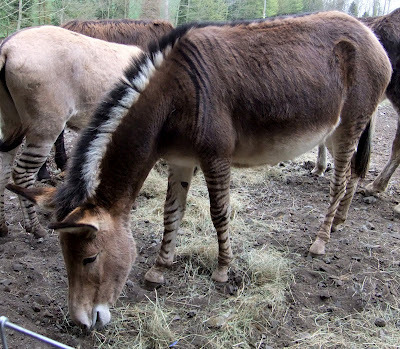 Zambi has a very striking black-and-white mane (Dr Karl Shuker)
Zambi has a very striking black-and-white mane (Dr Karl Shuker)After having finally seen a zebronkey in the flesh, it is easy to understand why more than one writer in the past has labelled this equine hybrid "a donkey in pyjamas"!
Certainly the singularly attractive appearance of zebronkeys, especially when young (as evinced by the incorrigibly cute youngster from Colchester Zoo pictured on the front cover of the 1971 second edition of Annie P. Gray's standard work Mammalian Hybrids – see this present ShukerNature post's opening picture), will guarantee their continuing popularity in zoos, parks, and other wildlife centres. Like zorses, zebronkeys are normally sterile, but fertile female specimens have occasionally been reported.
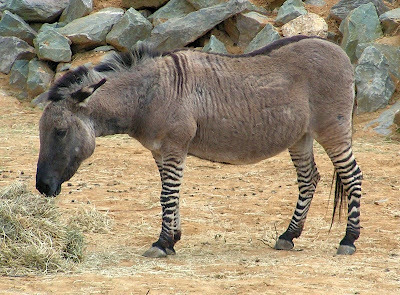 A zonkey (aka zebronkey) at Colchester Zoo in 2004 (Sannse/Wikipedia)
A zonkey (aka zebronkey) at Colchester Zoo in 2004 (Sannse/Wikipedia)Some Grant's zebronkeys were used in the past as pack animals in Kenya, and proved to be strong workers, but were apparently less intelligent and more difficult to work with than zorses.
A ZEEDONK NAMED ZEE
Described on Donkey Rescue UK's 'Donkey Mixtures' webpage (click here ) as "very much a zebra – disguised as a donkey!" on account of her very strong and bossy zebra-like personality, Zee was bred in the Netherlands and came to the UK in 2011.
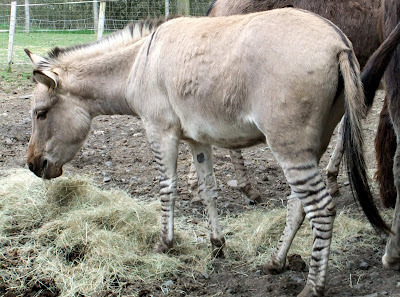 Zee the zeedonk at Donkey Rescue UK (Dr Karl Shuker)
Zee the zeedonk at Donkey Rescue UK (Dr Karl Shuker)She is the rarest member of Donkey Rescue UK's trio of zebroids because she is an example of the much less common reciprocal cross between zebras and donkeys – a zeedonk or donkra - having a standard donkey as her father and a Grant's zebra as her mother.
A TRIPLE ZEBROID
Rarest of all zebroids, however, must surely be the triple hybrid once exhibited at London Zoo and documented as follows by none other than Charles Darwin in his book The Variation of Animals and Plants Under Domestication (1868):
"Many years ago I saw in the Zoological Gardens a curious triple hybrid, from a bay mare, by a hybrid from a male ass and female zebra. This animal when old had hardly any stripes; but I was assured by the superintendent, that when young it had shoulder-stripes, and faint stripes on its flanks and legs. I mention this case more especially as an instance of the stripes being much plainer during youth than in old age."
This triple hybrid's father was thus a fertile male donkra, a great rarity in itself.
QUORSES AND HUAGGAS?
If the above-mentioned triple hybrid is the rarest zebroid, then the most controversial zebroids must surely be ones that allegedly featured as one of their parents the now-extinct quagga E. q. quagga.
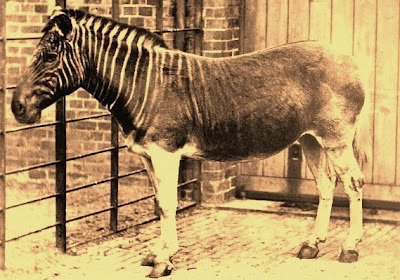 A captive female quagga at London Zoo in 1870, which was the only living quagga specimen ever photographed.
A captive female quagga at London Zoo in 1870, which was the only living quagga specimen ever photographed.The only partially-striped zebra, being fully striped upon its face, neck, and shoulders, but entirely lacking stripes upon its legs and hind regions, and only faintly striped upon the mid-portion of its body, this very distinctive subspecies of the plains zebra was once common on the veldt of South Africa. Following persecution at the guns of hunters for its meat and hide, however, it was eventually wiped out entirely in the wild, and the last surviving captive specimen, at Amsterdam Zoo, died in 1883.
Intriguingly, several decades prior to this tragic end, there were several claims of hybrids having been bred between quaggas and horses.
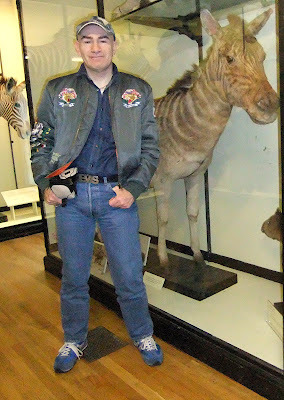 Standing alongside a taxiderm quagga at Tring Natural History Museum (Dr Karl Shuker)
Standing alongside a taxiderm quagga at Tring Natural History Museum (Dr Karl Shuker)Not everyone accepts these claims, however, believing that the zebras involved were not quaggas but Burchell's zebra E. q. burchelli. Having said that, this is a controversy within a controversy, because researches have recently revealed that this unusual zebra subspecies - also known as the bontequagga, characterised by distinctive pale-brown shadow stripes present between the normal dark ones, and allegedly becoming extinct approximately 40 years after the quagga - was not a valid subspecies at all.
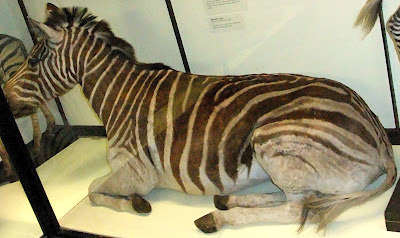 Taxiderm specimen of Burchell's zebra at Tring Natural History Museum (Dr Karl Shuker)
Taxiderm specimen of Burchell's zebra at Tring Natural History Museum (Dr Karl Shuker)Instead, it had merely been based upon aberrantly-patterned individuals belonging to the Damara zebra subspecies, E. q. antiquorum, and that some specimens of Damara zebra alive today show precisely the same characteristics as those documented for Burchell's zebra. So even though the latter version never existed as a separate taxonomic form, it is no longer extinct!
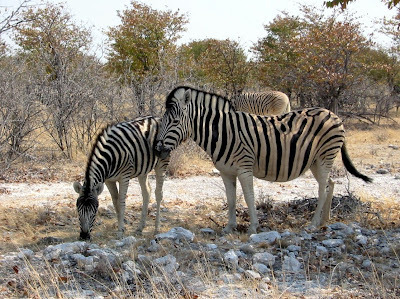 Living zebras at Etosha, in Namibia, exhibiting the characteristic appearance of Burchell's zebra
Living zebras at Etosha, in Namibia, exhibiting the characteristic appearance of Burchell's zebraProbably the most famous alleged quagga-derived zebroid is a female hybrid bred in 1815 by Lord Morton (George Douglas, 16th Earl of Morton) from a supposed ♂quagga x ♀chestnut Arab horse mating.
Unlike zebra x horse hybrids, and quite possibly because there is no absolute confirmation that any ever existed, quagga x horse hybrids have never received their own specific terms. Consequently, for ease of reference in future, and utilising the same system of nomenclature employed in relation to other zebroid types, I propose that a ♂quagga x ♀horse hybrid (whether confirmed or alleged) be referred to hereafter as a quorse, and a hybrid from the reciprocal cross as a huagga.
Although there will be no quorses and huaggas on show there, I can guarantee that if you visit Donkey Rescue UK, you will have a thoroughly enjoyable experience, with the chance to see not only its three remarkable zebroids but also a number of other very engaging equids, including Mammoth Jackstock donkeys (the world's largest breed of donkey), an adorable young shaggy-haired Livre A Baudet du Poitou Jack donkey from France, and a Mediterranean miniature donkey, as well as some beautiful horses and ponies. So please check out their website here and pay them a visit one weekend – you won't be disappointed!
My photographs of its zebroids are included here by kind permission of Donkey Rescue UK.
 At Tring with a taxiderm quagga (Dr Karl Shuker)
At Tring with a taxiderm quagga (Dr Karl Shuker)
Published on April 08, 2012 18:00
April 5, 2012
THE ASWANGS OF ANTIPOLO - VAMPIRE DEMONS OF THE PHILIPPINES.
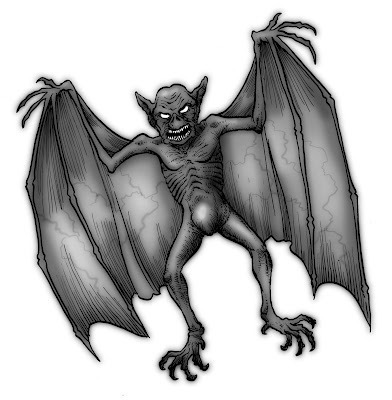 Berbalangs resemble humanoid bats (Richard Svensson)
Berbalangs resemble humanoid bats (Richard Svensson)I have long planned to write a novel, especially one infused with elements of fantasy and featuring traditional but little-known mythological entities, but other projects have so far taken up all of my available time. However, I am currently experimenting during whatever spare time I can find by writing short stories in this specific vein, interspersed with factual commentary. Here is one of my stories.
Today, tales of vampires are largely confined to novels, television series, and films, especially in the Western world. In the Philippines, conversely, the fear of what are widely considered there to be real, and very dangerous, supernatural bloodsuckers, lives on – as do, at least allegedly, these entities themselves. Nor is there just one type of Filipino vampire either. On the contrary, a bewildering, somewhat interchangeable array of forms and sexes have been reported, named, and classified. Among the best-known are the berbalangs of Mapun Island, which resemble monstrous humanoid bats but whose astral essence departs their physical bodies at nights to infiltrate those of sleeping humans, whereupon these fiendish horrors feed upon their victims' entrails. The predominant category of Filipino vampires, however, comprises the aswangs.
These demonic sanguinivores are very skilful shape-shifters, so it is by no means easy to identify one with certainty. A dog, a cat, a bird, a bat, any fairly large, poorly seen 'thing with wings', a wild pig, and, most seductive and dangerous of all, a young, beautiful woman – a single aswang can adopt any or all of these guises to approach its intended target and beguile anyone who may be protecting the latter person. Moreover, they are assisted by a number of other beings, acting as familiars, including certain small birds, and a bizarre large-fanged, spotted, furry beast known as the sigbin, which has been likened by some investigators to the West Indian chupacabra!
The aswang's favourite targets are unborn children and freshly-buried corpses. Not surprisingly, therefore, the months of pregnancy in a region reputedly blighted by these foul creatures are a time of fear and great danger for women, as is the wake after a funeral, when everyone is on full alert to the possibility that it will be infiltrated by a disguised aswang, intent upon devouring the corpse.
Even today, an unexpected miscarriage or stillborn child is often blamed upon some undetected visitation by an aswang, and it is widely believed that if an aswang succeeds in removing and consuming a corpse, it will replace the cadaver with a detailed facsimile adeptly constructed from banana leaves or other vegetable matter.
Nor are such superstitions and folk-beliefs limited to isolated rural areas. With the sole exception of the Ilocos region in the northwest portion of Luzon (the Philippines' largest island), the entire Philippine archipelago is still heavily infused and infested with legends, lore, and religious dread of aswangs and their hideous practices. The epicentre of such belief, however, is unquestionably the Visayan region (a group of isles south of Luzon), particularly the western provinces of Capiz (on Panay Island), Iloilo, and Antique. Indeed, Capiz is widely claimed to be the most supernatural locality within the entire Filipino nation, and homes here are routinely adorned even today with garlic bulbs, holy water, and other aswang repellents.
But if any one city can be singled out as the vampire capital of the Philippines, it has to be Antipolo, just 25 km or so east of the country's capital, Manila, and situated in the southern portion of Luzon. Here, aswangs are said to be glimpsed on a frequent basis, but never more so than during the Holy Week (the equivalent there of Easter), and attracting a zenith of reports during the three days between Jesus Christ's death and His resurrection.
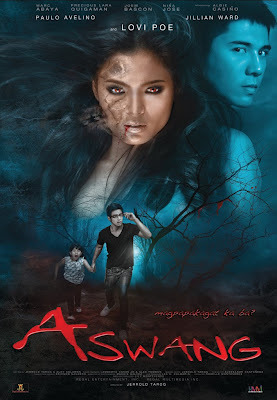 Movie poster for 'Aswang' - a smash-hit film released in the Philippines in 2011 (Regal Entertainment)
Movie poster for 'Aswang' - a smash-hit film released in the Philippines in 2011 (Regal Entertainment)Of the varied forms adopted by the aswangs, the most formidable is the human version, sometimes confused with a mere witch or hag, but which is known as the manananggal. Being humanoid, it bears more of a resemblance to western vampires than do the other, animal-assuming aswang types, but in addition to being vulnerable to such well known vampire deterrents as garlic, bright sunlight, and salt, the manananggal can also be warded off using such exotica as spices (particularly ginger), vinegar, the sword-like bill of a swordfish, and the tail of a stingray. Again like western vampires, the manananggal can fly, but it doesn't change into a bat to accomplish this. On the contrary, its modus operandi for becoming airborne is far more grotesque and terrifying than that, as will now be revealed here.
The following scenario is a reconstruction of a typical manananggal incident according to local lore, in which I've attempted to incorporate as many of the strange and unexpected facets of this age-old but tenacious Filipino myth as possible:
Ever since she had arrived with her father in Antipolo several years earlier, Rosa had always been shy and retiring. Pleasant and respectful, certainly, but never outward-going or even overly communicative. Her father blamed himself, as fathers always do, believing that because her mother had died giving birth to her, he as a man had been unable to endow her with those innately-feminine social skills that other young women here seemed to possess in such abundance.
Still, as she had now reached the age when certain other aspects of her personality and appearance had begun to attract the attention of the local youths, soon she may no longer be her father's responsibility anyway. Also, as she was training to be a midwife, it would not be long before she would be self-sufficient financially too. How time had flown, he mused – it seemed only yesterday that she had still been just a girl, tightly holding his hand when they had disembarked from the train that had taken them far from their previous home in a small rural village where nothing much ever happened to the ceaseless bustle and clamour of the big city - Antipolo.
Yet even here, shadows of the past, and ancient irrational fears, still linger. Tonight, Rosa would be going to the home of Maria, a friend, and staying with her overnight until her brother arrived there from overseas, where he would remain until Maria, now seven months pregnant, gave birth to her child. Prior to then, Maria had been living with her sister, but she had moved out that morning to live thereafter in a different area of the city in order to be nearer her new job, which left Maria alone in the house that they had been sharing. But what was so problematic about Maria living alone in their house now? She was a healthy, perfectly capable woman, and it was only for one night after all. The explanation was a single word – and the word was 'manananggal'.
Even in the 21st Century, the age of ultra-technology and medical advances beyond the wildest dreams of all previous generations, and even in as modern a city as Antipolo, the age-old terror of night demons, and manananggals in particular, still surfaced at certain times, especially at wakes and during the nine months of pregnancy. So much so, in fact, that families did everything possible to ensure that pregnant women were never left alone at night, not even for a single evening, until the baby had been born. And even afterwards, right up until the baby had become a teenager, its parents would always be watchful, and never more so if they happened to live on the city's outskirts, as Maria did, where the jungles and unploughed meadowlands threatened ever to encroach upon the swathe of civilisation that had been savagely carved out of their wild, verdant territory by humankind.
And so, before evening had chance to fall, Rosa was setting off on foot, walking swiftly through a series of fields that offered the speediest pathway to her friend's house, and thus avoiding the hideously congested thoroughfares whose traffic belched smoke and noise unceasingly. In contrast, only a single car drove past as she walked along this lonely rural route.
However, every step that she took was being matched by someone – or, rather, something far less welcome, and infinitely more terrifying. True, it looked like a young woman right now, but not for much longer would it do so. The manananggal – for that is indeed what it was - came to a large group of tall trees whose shadows amalgamated and coalesced like a wide black pool, hidden completely from view. Stepping into this pool of shadows, the manananggal took off its human clothes and hid them in some bushes. Then an incredible transformation took place.
Its human face's complexion blanched to a ghostly pallor, a pair of long sharp fangs grew downwards until they protruded from its half-closed mouth, which lengthened until it resembled the jaws of some malign reptile, and emerging from their tip, flickering evilly, was a slender red fork-tipped tongue, closely resembling that of some vile serpent. But most terrible of all were its eyes. Gone were its round blue human irises, and in their stead was a pair of vertical golden slits, each one containing an even thinner black slit.
But if, somehow, anyone had been watching all of this, not even that latter dramatic change of form would have prepared them for the horrifying climax to this unholy metamorphosis. Without any prior warning, a dark horizontal ring spontaneously encircled the creature's still-human waist. Then, a mere instant later, incredibly, the top half of the manananggal's body - everything from its waist upwards - abruptly separated from its lower half. And as it did so, a pair of splits appeared in the skin concealing its shoulder blades, and out of these splits unfurled a pair of very large, dark, bat-like wings, whose flapping leathery pinions carried it aloft into the air, leaving behind the creature's lower body half and legs, standing there as lifeless as the bottom portion of a tailor's dummy in a shop window, but completely hidden from sight amid the shadows of the trees.
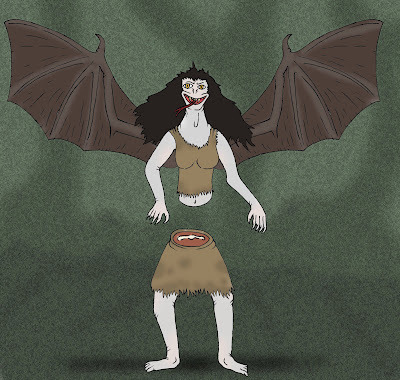 Artistic reconstruction of a manananggal (Tim Morris)
Artistic reconstruction of a manananggal (Tim Morris)It is always imperative for a manananggal to locate a secure hiding place for its lower half, because if anyone finds it while the manananggal is away, they can kill this vampire merely by sprinkling salt or smearing sand, garlic, or ash upon the lower half's open edge, or by burning it entirely. For when the manananggal returns, if it cannot rejoin its two halves to become whole again it dies.
By now, the sky was growing dark, and the grotesque half-manananggal flew swiftly on to the home of Maria. But would it find her still alone – had it arrived in time? It soon had its answer – in the form of a series of strange cries, sounding just like 'tik-tik', which were being given voice to by a small owl-like bird sitting on the roof. At a casual glance, it could have been mistaken for a real owl, but a closer look would have revealed that its fine feathers were actually hairs, not plumes, and its eyes glowed an infernal red. This was the manananggal's hellish familiar or lookout, the tiktik, named after its cries - which confirmed to the manananggal that the house's occupant was still alone.
The manananggal's tongue thrashed like a veritable serpent, and two golden drops of venom drooled from its jaws. Now, just one more transformation was needed. Its human half-body became amorphous as it hovered just outside the house, remoulding itself into a new form, one that included a fairly long, repulsively-wrinkled body, and two slender hind legs with three toes on each foot, together with the large wings that remained unchanged from its previous incarnation. Its elongate head possessed a pair of huge glowing ovoid eyes, a red slit-like mouth, and, most bizarre of all, an extremely lengthy, slender proboscis that emerged from its large black nose, and undulated sinuously in front of its malevolent face.
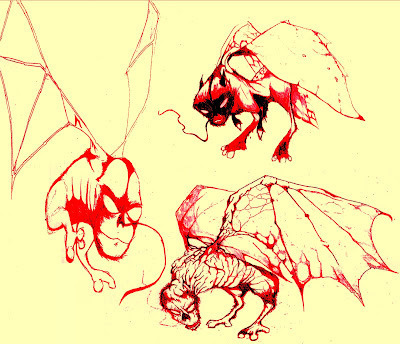 Artistic representations of the manananggal's proboscis-nosed form (Ben Male)
Artistic representations of the manananggal's proboscis-nosed form (Ben Male)As expected, the doors and windows were all tightly closed, and a roaring fire in the hearth prevented any possibility of entering down the chimney. But like all vampires, the manananggal was not bereft of ways in which to enter a seemingly impenetrable, unbreachable building. The roof was thatched, and it did not take the manananggal long to burrow through a weak patch of thatching until it had forced its way into the top storey of the house. Silently it flitted downstairs, its acute sense of smell confirming that Maria was there, and not in any of the bedrooms as it had initially anticipated. Sure enough, there she was, sitting in a large chair close to the fire, where, no doubt lulled by its comforting warmth, she had fallen asleep – and so had never seen that the bottle of special protective plant oil standing on a shelf close by was bubbling and frothing, warning of the manananggal's presence.
The manananggal was now on the floor, and was stealthily walking towards her on its two legs, its large wings folded up and held over its back. Its serpentine proboscis flickered and twitched incessantly. Already it could smell and even taste in the air the scent of its prey – Maria's unborn baby!
After just a few moments, the manananggal was squatting directly in front of Maria, on the floor at her feet. On account of her size and the very advanced stage of her pregnancy, Maria was wearing only a large maternity dress with no uncomfortable underwear to grip tightly. Slowly, the manananggal's long proboscis rose upwards, cautiously, ensuring that it did not wake Maria as it gradually moved up between her calves and thighs, steadily approaching her vagina, which would in turn lead directly to her baby inside her womb. And once the proboscis reached the baby, it would apply its suckered tip to the helpless foetus and drain it not only of blood but also of its very life force until it died, murdered within its own mother's body by a foul creature of nightmare. Had the foetus been smaller, just a few weeks old, the manananggal would have sucked it out entirely and consumed it.
Just a few more centimetres and its proboscis would be there, and then... But before it could even contemplate that, the still of the night was abruptly broken by a series of very loud 'tik-tik' cries directly overhead. It was the manananggal's familiar – something was wrong, somebody must be approaching the house! The manananggal's proboscis retracted instantly, but at the same moment Maria awoke, the tiktik's cries having shaken her out of her deep warmth-induced slumber. Her eyes opened, and the first thing that she saw was a hideous rat-like horror on the ground at her feet. But even as she stared at it, it began to shuffle off on its two legs and a large pair of bat-like wings opened up above its back.
Involuntarily, Maria snapped open her mouth and screamed at the top of her voice, over and over again, shrieking and howling with uncontrollable hysterical terror and horror at what she had seen - what she knew to be a manananggal! Then she saw the table nearby, and the large box on it, which had been left there by her sister that very morning. They had both joked about it at the time, especially about some of its bizarre contents, never believing that these would ever be needed – but they were sorely needed now. For what the box contained was a wide selection of items guaranteed, at least according to traditional Filipino lore, to dispel manananggals. But surely this was all just superstition – wasn't it? Yet the manananggal was only too real, so perhaps these assorted objects' power would be too.
Quickly, Maria opened the box and tipped its contents out on the table. They were certainly an extraordinarily diverse, eclectic assemblage. A red pouch full of ginger and coins. The dried penis of a horse. A faded photograph of her grandmother. A bag of salt. A whip fabricated from the somewhat desiccated tail of a stingray. A long silver dagger. Scrabbling among them, she grabbed the bag of salt and hurled its contents over the retreating manananggal, which let forth an ear-splitting screech as its skin began to burn and sizzle where the salt had landed upon it.
Raising its head, its eyes glowing in fury, the manananggal turned around, and then stepped forward towards her, its red mouth open wide in hissing rage. Swiftly, Maria snatched up the horse penis in one hand and her grandmother's photo in the other, and brandished them towards the approaching vampire. Instantly, it stopped in its tracks, its golden eyes now flashing in panic, because phallic objects and images of elderly women are items that, for reasons long since lost in the mists of bygone ages, induce outright terror in the minds of all manananggals. It opened its wings fully, in an attempt to fly up and away from the frightening objects, but as it did so, Maria began thrashing at it with the stingray-tail whip, hoping that its sharp barbs would pierce the manananggal's skin - already blistered and raw from the effects of the salt.
Just as she did so, however, a loud beating was heard upon the main door. Rosa! She'd arrived at last! Why had it taken her so long? Maria shouted out, just to make sure that it was indeed Rosa – but it wasn't. It was her brother, Juan! Maria raced to the door, unbolted it, hauled it open, and dragged a startled Juan inside. Without saying a word, she pointed at the manananggal, flapping overhead, and handed him the silver dagger, because if he could stab this loathsome entity with a weapon fashioned from silver, it would die. But even as Juan grasped the dagger, the manananggal had spotted an escape route. In the rush to get Juan inside, Maria hadn't closed the door!
In the space of a second, the manananggal had flown through the still-ajar door and out – onwards and away into the night sky, accompanied by the tiktik, and free to attempt further attacks elsewhere. But at least the nightmare for Maria and her unborn child was over (although her brother swiftly placed a circle of protective coins from the red pouch on the floor all around her as she sat back on the chair, just in case). Juan had managed to catch an earlier train, which was why he was here tonight, and not the following morning as expected - but as Rosa had never appeared, that was just as well.
The manananggal flew back to the group of trees where it had concealed its lower half. When it reached them, it transformed back into its human upper half, which then settled upon its lower, and united with it at once, becoming a whole woman again. Afterwards, it swiftly dressed itself in the human clothes that it had originally been wearing but which it had concealed with its lower half earlier that evening. Then back towards the city walked Rosa – for the manananggal and Rosa were, of course, one and the same entity.
But they hadn't always been. When the original Rosa, the real daughter of her father, was four years old, one hot febrile night a manananggal had surreptitiously found its way into her bedroom while she was asleep, and had silently drained her of her life force until she was dead. Then, once again without making even the faintest of sounds, it had stripped Rosa's clothes from her small cold body, which it had then devoured entirely, before shape-shifting itself into an exact likeness of her when alive, then dressing itself in her clothes. And no-one, not even Rosa's own father, had ever suspected that anything was amiss. Or at least, not until, down through the years, an inordinate number of pregnant women in their village and others nearby had suffered miscarriages, given birth to stillborn babies, and in some cases had even experienced what had appeared to be an unexplained total reabsorbing of the foetus while still only a few weeks old.
Eventually, suspicious fingers had begun to point towards the withdrawn, uncommunicative, secretive Rosa. And even though her father had angrily denounced all such accusations, pointing out that they had lived together ever since Rosa's birth – it was not as if Rosa had been adopted by him and was therefore of unknown origin, or had even been separated from him for any length of time – finally he had decided that they should move far away, which is what had brought them to Antipolo.
But once again, miscarriages and stillborn babies had lately been occurring with increasing frequency in areas of the city close to theirs, and sometimes near to their own home. However, the city was far bigger than their village, and Rosa knew that the number of cases overall was too small to attract unwelcome attention. So she would be safe, and would remain undetected here for a long time, assuaging her bloodlust without fear of discovery.
Back home, Rosa sat in her room, getting ready for dinner with her father downstairs. Her father – she smiled as those words entered her mind. Even at the heights of her bloodlusts, her father was the one human figure that had always remained inviolate, never at risk of being attacked by her, because as a child and even as a teenager she had depended entirely upon him to protect her physically from those who had grown suspicious, and also to dispel rumours that might otherwise have led to formal investigations. Of course, now that she was no longer a teenager, now that she was a grown woman soon to qualify as a midwife – and trembling with something akin to erotic ecstasy at the thought of the unchallenged access that this job would give her to pregnant women! – from now on she would be able to stand up for herself. Her father would no longer be invaluable, or even valuable. On the contrary, he was now entirely disposable.
And as she reflected upon this, her face glimmered with a pale, unearthly glow, as for just the briefest of instants her eyes became golden vertical slits, and a pair of long venom-dripping fangs momentarily materialised. Then, the voice of her father called up to her, to tell her that dinner was now ready. Instantaneously, her face became that of his obedient daughter Rosa again, except for the faintest of smiles that lingered as she stood up. After all, she speculated, tonight would be as good a time as any to bring this charade to an end, and the death of her father would appear to anyone examining his body to have been caused by nothing more dramatic than a massive heart attack. The shock of her father's sudden, unexpected demise would even very conveniently explain why she hadn't gone to Maria's house that evening as promised. She walked out of her bedroom, closed the door, and walked along the landing towards the stairs. Yes, it was time...
Downstairs, her father stood motionless, willing his mind and his heart to accept what must be done. A few minutes earlier, he had received a phone-call from a near-hysterical Maria, who, with her brother Juan's help, had somehow managed to convey what had happened with the manananggal, and that they fervently hoped all was well with Rosa, as she had never arrived at Maria's house. When he put the phone down, Rosa's father was ashen and shaking. He knew very well that Rosa had set out, because a friend driving by in his car had happened to see her walking through the fields not far from Maria's house. Yet when Rosa had unexpectedly arrived back home only a few hours later, she had gone straight to her room without even speaking, let alone explaining why she hadn't stayed at Maria's. He had naturally assumed that she would explain everything at dinner, but the horrific news from Maria had driven all other thoughts from his mind – all other thoughts but one, that is.
So, it had indeed begun again, and closer to home in every sense this time than ever before. After all, Maria was a good friend. How could it be? It cannot be, surely – and yet, it must be. No longer was there any other explanation. No longer could there be any further attempt to brush aside such events as mere coincidences.
He glanced at an open drawer in his writing desk, then looked down at his hand, at what he had taken out of that drawer and was now holding, which gleamed brightly even in the evening's subdued light. It was a long slender dagger, with a razor-sharp blade. A silver dagger.
He stood in the shadows at the foot of the stairs, and waited. Yes, it was time...
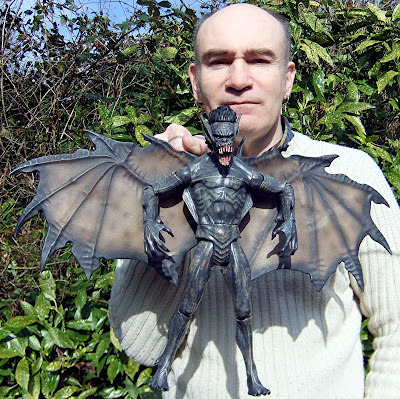 With my very own berbalang! (Dr Karl Shuker)
With my very own berbalang! (Dr Karl Shuker)
Published on April 05, 2012 15:13
March 26, 2012
MY INTERVIEW WITH MONGABAY.COM ON NEW AND REDISCOVERED ANIMALS
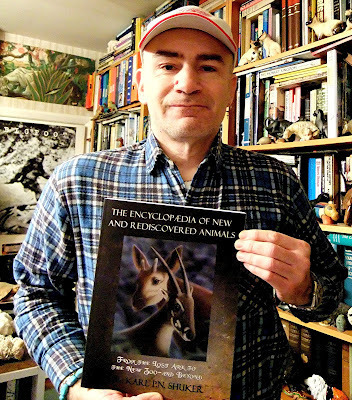
Click here for my interview with Mongabay.com on the subjects of new and rediscovered animals, cryptozoology, my new book The Encyclopaedia of New and Rediscovered Animals (Coachwhip: Landisville, 2012), and the newly-launched Journal of Cryptozoology.
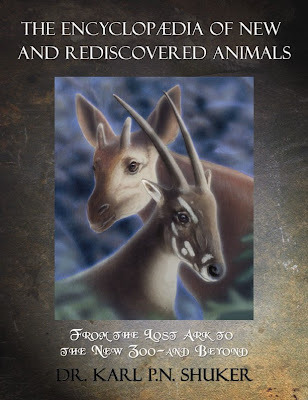
Published on March 26, 2012 14:55
March 13, 2012
MYSTERY CATS IN SHOWBUSINESS - YOUR ASSISTANCE IS REQUESTED!
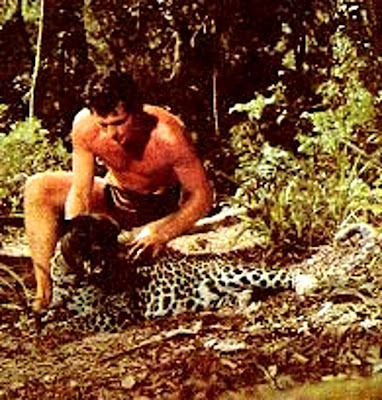 A still from the 'Tarzan' television series of the 1960s showing Tarzan (Ron Ely) alongside a black-headed leopard (still emailed to me by Bill Rebsamen)
A still from the 'Tarzan' television series of the 1960s showing Tarzan (Ron Ely) alongside a black-headed leopard (still emailed to me by Bill Rebsamen)The entertainment world may not be the most likely realm in which to encounter real-life mystery cats, but a number of intriguing examples have cropped up here from time to time, including the following two cases - neither of which has been resolved so far.
A BLACK TIGER IN THE CIRCUS?
Melanistic (all-black) specimens of leopards Panthera pardus (commonly termed black panthers) and jaguars P. onca are well known. Conversely, although there have been many reports of all-black tigers P. tigris (see my book Mystery Cats of the World, 1989, for the first - and still the most detailed - review of cases ever published), not a single specimen or skin of one has ever been formally submitted for scientific examination and verification.
Consequently, in the absence of a specimen, fully melanistic tigers are still regarded as cats of cryptozoology, even though there is no sound zoological or genetic reason why all-black mutants of this species should not arise from time to time. Hence I was greatly excited when I received an e-mail from Arkansas wildlife artist William M. Rebsamen on 3 October 1997 in which he recalled seeing a photo of a living black tiger in a book! According to Bill:
"I remember once seeing a large book about the history of the Ringling Brothers Circus and was surprised to find a clear photo of a big cat trainer with a "Black" tiger (you could still make out his stripes though) mixed in with his normal Bengals. Is this for real?"
If only I knew! However, the fact that its stripes could still be discerned against its fur's black background colouration is precisely what one would expect with a genuine melanistic tiger, just as the rosettes of black leopards and jaguars can be perceived against their fur's ebony ground colour when viewed closely or at certain angles.
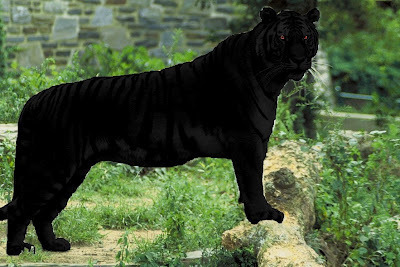 Computer-generated mock-up of the likely morphology of a melanistic tiger (Dr Karl Shuker)
Computer-generated mock-up of the likely morphology of a melanistic tiger (Dr Karl Shuker)Needless to say, I lost no time in requesting any further information that Bill could recall concerning this fascinating disclosure, and on 15 October I received the following details:
"Sorry for the uncertainty of my memory concerning the black tiger photo but the best I can remember [is] it was a coffee table sized, hardcover book. My best recollection is that the title was "The History of Ringling Bros. and Barnum & Bailey Circus". I'm sure it would have been around 1974 or 1975 when I saw the book, new, in a bookstore at our local mall. The photo was in towards the middle of the book. It pictured a trainer in a cage with 4 or 5 bengals, one appearing to be black.
"I hope this isn't another case like the "Thunderbird Photo", but I can assure you, as a young kid of about 10 or 11 at the time, I was thoroughly fascinated with big cats and would go to the mall every Saturday for as long as that book store was in business and I would look at that photo. I don't know why it never crossed my mind to ask my mom to buy it for me. I do know that for that age I could distinguish big cat subtleties (like the still visible spots on a black leopard) and was amazed by this photo because it appeared to show stripes under the dark fur."
The late Mark Chorvinsky, Strange Magazine's founding editor and a longstanding friend of mine, had a lifelong interest and extensive knowledge of circus history, so I swiftly informed him of Bill's remarkable news, and Mark promptly contacted the Ringling Brothers Circus requesting any information that they could send concerning this melanistic mystery. Sadly, however, he never received any reply, but Bill and I have continued to collaborate fully in pursuing this compelling mystery in the hope of uncovering not only the photo but, as a result, proof that a living black tiger was actually maintained in captivity!
Another cryptozoological researcher who greatly assisted us was the late Scott T. Norman, from California. After receiving details from Bill, Scott conducted some extensive Internet searches and sent out many requests for information relating to this photo. Again, however, no further details were forthcoming.
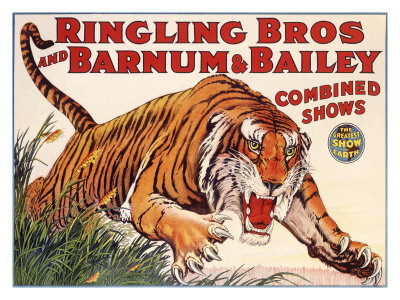 Ringling Brothers Circus poster depicting a normal tiger
Ringling Brothers Circus poster depicting a normal tigerHas anyone reading this ShukerNature blog post seen the book and the all-important photograph inside it referred to by Bill? Or does anyone have any additional information concerning the possible presence of a black tiger in the Ringling Brothers Circus? If so, I'd greatly welcome any details that you could send to me or post here.
TARZAN AND THE BLACK-HEADED LEOPARD
Remarkably, the above feline enigma is not the only mystery cat from the realms of showbusiness whose apparent existence has been brought to my attention by Bill Rebsamen. Bill also very kindly alerted me to the curious black-headed leopard that appeared in an episode of the 'Tarzan' television series from the 1960s, starring Ron Ely in the title role. According to Bill, in the storyline of this particular episode Tarzan's sidekick was a 12-year-old boy from India who had made friends with a spotted leopard that was black from the neck up, and which was being pursued by evil fortune-hunting poachers. After a number of e-mails and Internet requests, Bill succeeded in obtaining a copy of a frame from the episode, shown above at the beginning of this ShukerNature post, depicting a black-headed leopard lying next to Ron Ely.
To my mind, this animal was probably 'created' in the series' make-up department, as the black head and neck colouration is precisely delineated from the spotted remainder of the beast, whereas one might have expected a rather more blurred demarcation if the leopard's pigmentation had been genuine. Also, I assume it is this odd colouration that made it so valuable (in the story) to the poachers, who would not have been so concerned about tracking a normal leopard. Bill, however, is not so sure, noting in a November 1997 e-mail to me:
"It seems to me this [the black-headed leopard] may fall under the "stranger than fiction category" when you ask the question as to why would someone go through the trouble of dyeing the leopard's head black for a syndicated TV show watched by people who would, for the most part, not realize the significance of this rarity?"
If its rarity is not specifically alluded to in the programme, then Bill does have a point. Also, it has to be conceded that transforming a leopard in this way would prevent any stock footage of leopards being used in that particular show (which is a common - and financially sensible! - practice when putting together a show containing a lot of animal footage).
Despite continued efforts, Bill did not succeed in his attempts to track down the show's producer, animal trainer, or anyone else with knowledge of this episode, in order to uncover the true identity and history of its melanocephalic animal star.
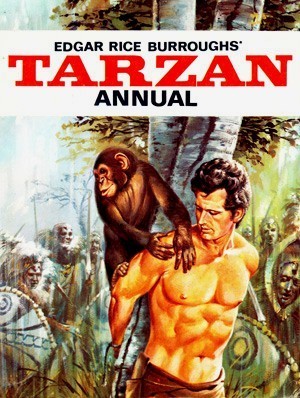 Annual from 1967 accompanying the 1960s 'Tarzan' television series starring Ron Ely
Annual from 1967 accompanying the 1960s 'Tarzan' television series starring Ron ElySo once again, if anyone reading this ShukerNature post has any relevant information, I'd love to hear from you - it may not be too late even now to solve yet another feline mystery emanating unexpectedly from the entertainment world.
Published on March 13, 2012 20:01
March 11, 2012
THE HORNED DEMON CAT OF WORLD WAR II - A TRUE STORY
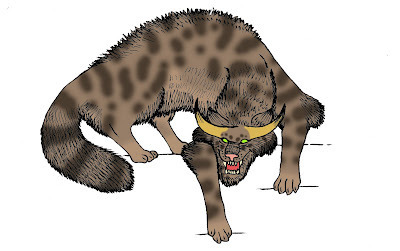 "Crouched upon the stair..." (Tim Morris)
"Crouched upon the stair..." (Tim Morris)It could have been a scene enacted from Dante's 'Inferno' - even the clouds seemed to be wreathed in flames as torrent after torrent of plummeting German bombs screamed through the darkened skies over south London, and danced a fiery tarantella of death upon its shuddering streets, like a flurry of shrieking souls in everlasting torment. And in the midst of this panorama of pandemonium was Howard Leland - one of many volunteers with the ARP (Air Raid Precautions) who had been boldly defying the deadly rain of missiles throughout that fearful evening in October 1943 in a desperate bid to minimise its malevolent effects. Little did Leland realise, however, that he would soon encounter something infinitely more sinister, and malign, than anything conjured forth by the wartime enemy.
As the ground reverberated from the intensity of yet another mighty explosion nearby, Leland ran into a deserted house to take shelter, until the immediate danger had passed. The building's interior was pitch-black, but with the aid of his torch he located a staircase, and rested on the bottom step for a while, waiting for this latest airborne assault to end.
Suddenly, a cold shadow of fear swept across him, for as he sat there he realised - indefinably but undeniably - that he was no longer alone in that house. Something - not someone - else was here too, close by, and watching him. Unbidden, his eyes gazed upwards, to the top of the stairs, and the feeling intensified. Surely there, concealed amid the stygian gloom, was the source of his fear - and now he would reveal its identity.
Leland switched on his torch again, directing its penetrating beam onto the topmost stair - and beheld a hellish sight that transfixed him with fear, expelling from his mind all of that evening's previous horrors in an instant. Crouched upon the stair was a huge hairy beast with tabby-like stripes of black and brown, clawed paws, and blazing eyes like glowed like twin infernos, mesmerising Leland with their incandescent gaze. It would have resembled a monstrous cat - had it not been for the pair of sharp pointed horns that protruded from its skull!
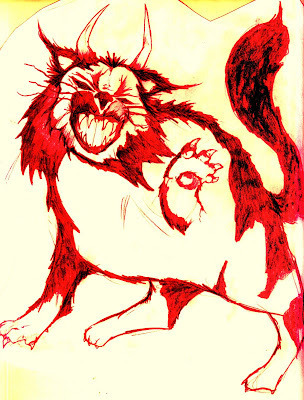 London's horned demon cat (Ben Male)
London's horned demon cat (Ben Male)For almost a minute, Leland remained motionless, held in thrall by the cold aura of palpable evil that radiated inexorably from the beast's unblinking eyes - and then it moved! With a single colossal leap, it sprang from the stair, plunging down into the shadowy room - but before it reached the ground, it had vanished. Yet its presence had not entirely gone - for Leland could plainly hear a spine-chilling yowling cry, echoing in the empty room.
At that same instant, however, the sound of human footsteps came from the open front door - and the spell was broken. The eldritch cries ceased immediately, and through the door walked two of Leland's ARP comrades. Their reassuringly familiar forms and voices swiftly dispersed the shroud of terror that had encompassed Leland only moments before, and encouraged him to recount his chilling experience. Neither of his friends had heard anything when entering the house, however, so he did not expect them to treat his account seriously - which is why he was so surprised when they listened silently and with grave expressions throughout his story, making no attempt to scoff or scorn his words.
When Leland had finished, his friends informed him that he was not the first person to have spied the feline monster. On the contrary, it had been seen by many different eyewitnesses over a period of several years, and the sightings were always the same - an immense horned cat with demonic eyes, squatting at the top of the stairs.
Nevertheless, in the hope that a more straightforward explanation may be forthcoming, the three men walked up the stairs and searched everywhere thoroughly for any physical evidence of the creature's reality, but nothing was found.
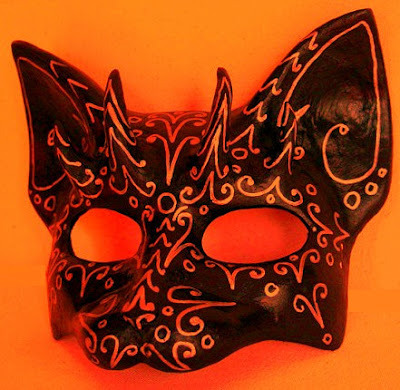 Horned demon cat mask
Horned demon cat maskStill disturbed by the memory of this grotesque entity but anxious to uncover its identity and possible significance, two days later Leland visited a renowned clairvoyant, John Pendragon, and recalled to him his encounter. After listening intently, Pendragon located the house on a large map of London, then placed a forefinger on the precise spot marking it.
At once, Pendragon's mind was filled with a whirling vista of cats - countless furry wraiths swirling all around at the top of the deserted house's stairs in a screeching, spitting vortex of feline fury, a mad maelstrom of undying hate. And at its very centre was something much larger, but it was not a cat - not even a horned demon cat. It was a man - haggard and despairing, with a noose in his hand, about to place it around his own neck.
After describing this vision to Leland, Pendragon asked him to make enquiries among the house's neighbours, to discover whether any details of its history and of its previous owners corresponded with those in his vision. A week later, Leland returned, bearing some extremely interesting (and vindicating) news.
One of the house's former inhabitants had been an ardent practitioner of the black arts, in the vain hope of improving what he had perceived to be a wretched, unfulfilled life. In accordance with one particularly grisly ritual, he had routinely slaughtered numerous cats for sacrifice upon an unholy altar. Ultimately, the balance of his mind had become totally unhinged, and he had committed suicide - hanging himself with a noose, suspended from the banister at the top of the stairs. Shortly afterwards, the great horned cat was seen there for the first time, and spectral yowling cries have often been heard since too.
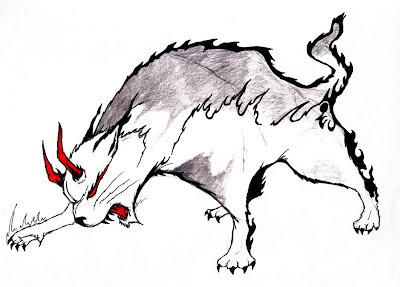 Was the horned demon cat an elemental? (Ben Male)
Was the horned demon cat an elemental? (Ben Male)When Leland asked his opinion as to this monster's precise nature, Pendragon suggested that it was probably an elemental spirit - one whose feline appearance and vitriolic hatred had been created by the restless ghosts of the departed sorcerer's many feline victims, and which would linger indefinitely in the grim locality where they had all met their terrible deaths.
Although the vast majority of Britain's mystery cats are unquestionably exotic non-native cats that have escaped or have been deliberately released from captivity, or are simple misidentifications of common animals, some investigators have speculated whether a few of them may in reality be paranormal (zooform) entities 'disguised' as big cats – as would certainly seem to have been the case with London's horned demon cat of World War Two.
Incidentally, it should be noted here that although the original source of this case was John Pendragon's autobiography, Pendragon (1968), which was written in collaboration with paranormal mysteries writer-investigator Brad Steiger, it only contained a fairly brief account of events. However, Steiger's own book, Bizarre Cats (1993), included a much more detailed, greatly expanded version as related to him by Pendragon, which not only emphasised the entity's feline nature but also incorporated other noteworthy additional information - such as the full name of the eyewitness (merely referred to by his initials in Pendragon's book), and the hideous cat-slaying rituals performed by the man who had subsequently committed suicide in the house where the horned demon cat was later seen.
This ShukerNature post is excerpted from my forthcoming book, Cats of Magic, Mythology, and Mystery, to be published by CFZ Press later this year.
Published on March 11, 2012 22:05
March 8, 2012
THE BLUE RHINOCEROS - IN QUEST OF THE KEITLOA
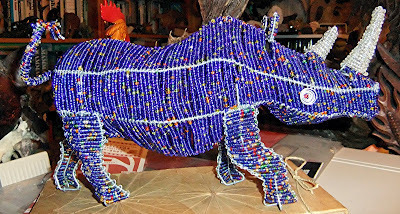 My very own blue rhinoceros(!), purchased in South Africa (Dr Karl Shuker)
My very own blue rhinoceros(!), purchased in South Africa (Dr Karl Shuker)During the 1800s, the standard natural history tomes documented a number of intriguing animals that seem to have slipped quietly into obscurity today. One such ex-creature is a mysterious African rhino - the exotic-sounding blue rhinoceros. It was apparently named after its greyish-blue colouration, although some illustrations of it (such as the famous, much-reproduced example below) depicted it with a brown hue, but was also referred to, rather more mundanely, as Sloan's rhinoceros or the keitloa.
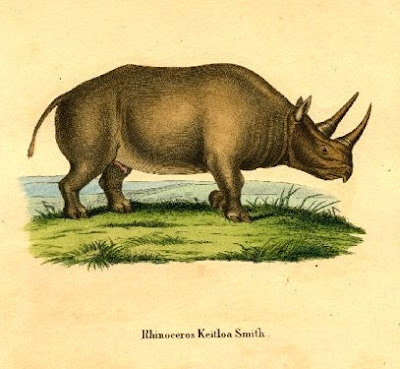 An unexpectedly brown-hued blue rhinoceros in a colour engraving from 1846
An unexpectedly brown-hued blue rhinoceros in a colour engraving from 1846Known scientifically as Rhinoceros keitloa, this was a relatively rare form, distributed sparingly south of the Zambezi, and not usually gregarious. In his Illustrated Natural History (1859-63), Rev J.G. Wood noted:
The keitloa can readily be recognised by the horns, which are of considerable length, and nearly equal to each other in measurement. This is always a morose and ill-tempered animal, and is even more to be dreaded than the borele [black rhino], on account of its greater size, strength, and length of horn. The upper lip of the Keitloa overlaps the lower even more than that of the borele; the neck is longer in proportion, and the head is not so thickly covered with wrinkles.
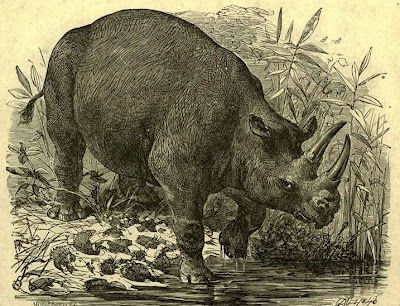 The blue rhinoceros as depicted in Wood's Illustrated Natural History
The blue rhinoceros as depicted in Wood's Illustrated Natural HistoryFormidably belligerent it may be, but some naturalists considered its credentials as a distinct species to be rather less impressive. W.B. Dawkins and H.W. Oakley, for example, within Prof. P. Martin Duncan's Cassell's Natural History, Vol. 2 (1883-9), commented that the blue rhinoceros or keitloa differed little from the black rhino, except for the shape of the head:
...which is somewhat shorter and broader, and it has a less prehensile lip. Its chief characteristic is the posterior horn, which is flattened at the sides, being of almost equal length to the anterior, and even occasionally longer, twenty inches and twenty-two inches being about the average.
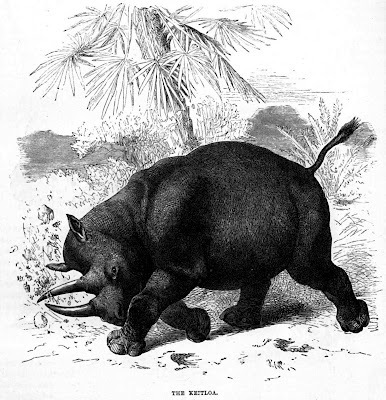 The blue rhinoceros as depicted in Cassell's Natural History
The blue rhinoceros as depicted in Cassell's Natural HistoryA short-lived controversy ensued during the second half of the 1800s, which was finally ended by the famous explorer Captain Frederick Selous. In a comprehensive paper published in the Zoological Society of London's Proceedings for 1881, and referring to an extensive collection of horns, Selous demonstrated conclusively that blue and black rhinos belong to the same species.
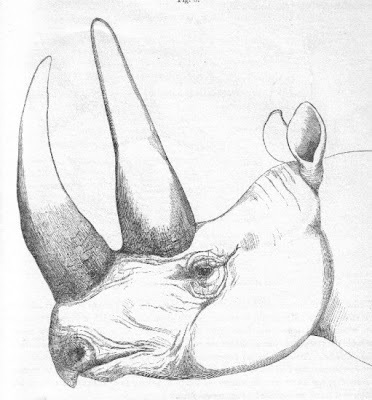 Head of a blue rhinoceros in the British Museum, 1876
Head of a blue rhinoceros in the British Museum, 1876Moreover, as noted in Rhinos: Endangered Species (1987) by Malcolm Penny, the difference in horn lengths was most probably due to environmental conditions: black rhinos inhabiting relatively dry localities are smaller and tend to possess shorter horns than those frequenting wetter terrain. Exit the blue rhinoceros!
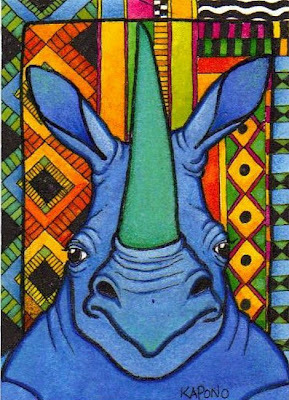 A blue rhinoceros, painted by artist Christina A. Kapono (Christina A. Kapono)
A blue rhinoceros, painted by artist Christina A. Kapono (Christina A. Kapono)
Published on March 08, 2012 01:28
March 6, 2012
MODERN-DAY NAGAS…OR PHOTOSHOPPED FRAUDS?
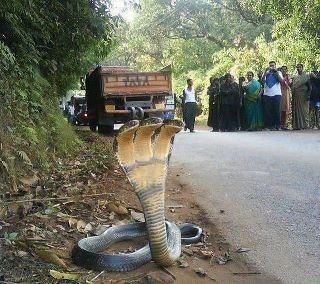
According to Hindu and Buddhist mythology, nagas are ancient serpent deities that can take human or semi-human form, and in Buddhist mythology a naga can have several heads. They are most often represented as huge cobras with expanded hoods.
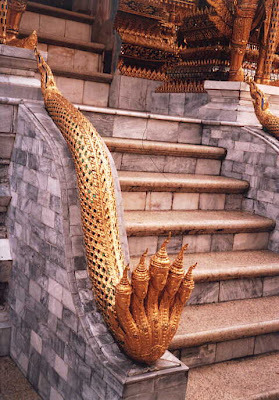 Ornate gilded statue of a naga at the Wat Phra Kaew in the Royal Palaces at Bangkok, Thailand (Dr Karl Shuker)
Ornate gilded statue of a naga at the Wat Phra Kaew in the Royal Palaces at Bangkok, Thailand (Dr Karl Shuker)One famous legend tells of how the Lord Buddha was shaded from the searing rays of the sun while asleep by the hoods of the multi-headed naga king Muchilinda – in another version of this story, Muchilinda protects him in this same manner from a severe rainstorm while he is meditating under the Bodhi tree.
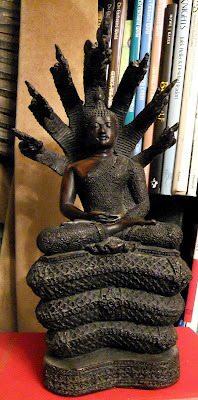 Figurine of the Lord Buddha meditating in the lotus position upon the coils of the naga king Muchilinda, whose hooded heads are shading and guarding him (Dr Karl Shuker)
Figurine of the Lord Buddha meditating in the lotus position upon the coils of the naga king Muchilinda, whose hooded heads are shading and guarding him (Dr Karl Shuker)Needless to say, however, no such thing as a multi-headed cobra exists in the realm of zoology. True, there are many fully-confirmed cases of two-headed snakes (click here to view a previous ShukerNature post of mine surveying a wide selection of examples), but nothing more dramatic. This is why, when several different people forwarded me the photo opening this ShukerNature post a few days ago I was intrigued – but only for a moment.
Closer observation made it readily apparent to me that this three-headed cobra owed its additional heads not to the fickle fortune of teratology but rather to the magical manipulation of Photoshop. For whereas a bona fide three-headed snake (assuming that such an entity could ever survive to adulthood anyway) would hold its heads at differing angles and heights, the "three little maids in a row" orientation of this photographed specimen clearly exposed its Photoshopped origin, in which the head of a normal cobra had simply been triplicated and the overlapping edges deftly blended to yield this eyecatching if wholly fake naga lookalike.
But don't take my word for it. Click here for a selection of other three-headed and also some five-headed Photoshopped cobras.
And if five heads aren't enough, here's an impressive nine-headed specimen, created by febing123
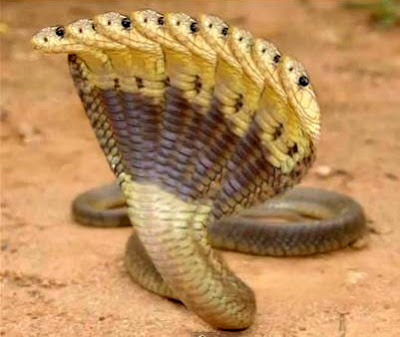
And here's an even more impressive twelve-headed specimen!
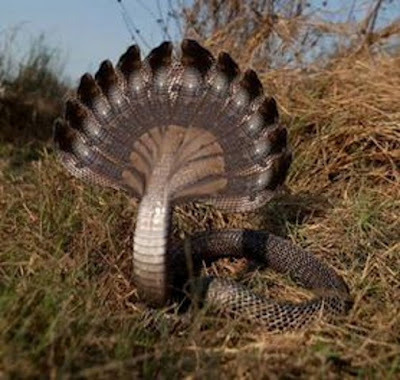
Finally, if you want a modern-day naga of your own, this is how to obtain one – just click here to view a YouTube video showing precisely how to create a five-headed cobra with Photoshop.
And then people wonder why I don't have much faith any more in photographic evidence alone when attempting to determine the validity of a cryptozoological case!
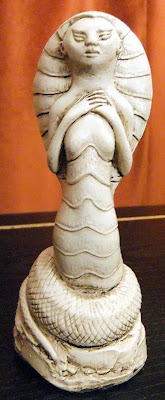 Figurine of a female naga or nagini (Dr Karl Shuker)
Figurine of a female naga or nagini (Dr Karl Shuker)
Published on March 06, 2012 04:12
March 4, 2012
TERROR OF THE TARASQUE!
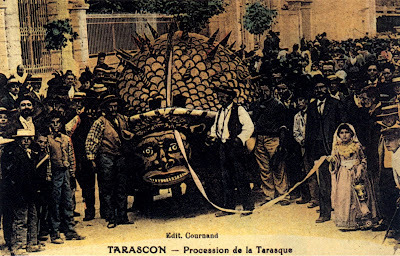 Tarasque festival at Tarascon, in Provence, France, with girl in white and holding leash on right of picture representing St Martha (Hand-coloured postcard from 1905)
Tarasque festival at Tarascon, in Provence, France, with girl in white and holding leash on right of picture representing St Martha (Hand-coloured postcard from 1905)The legend of the tarasque was the very first dragon account that I wrote for my book Dragons: A Natural History (Aurum Press/Simon & Schuster: London/New York, 1995) – the bestselling dragon book of all time, translated into over a dozen languages, and still in print today, 17 years after it was first published. Now, as a ShukerNature exclusive, here is the original but never-before-published, unabridged version of that account:
Medieval France was a time and a land of lingering, legendary monsters - anachronistic abominations left over from primeval ages. Singularly horrific was a neo-dragon called the tarasque - spawned by the biblical monster Leviathan, and originally from Galatia in Asia Minor, but which had come to haunt the banks of the River Rhône.
Evening was drawing in, and a traveller named Jacques du Bois quickened his step as he journeyed along the bank of the Rhône between Avignon and Arles in southern France. Nervously, he scanned the river's sable waters and the forbidding gloom of its fringing woodlands - his eyes questing for something that he fervently prayed he would not see.
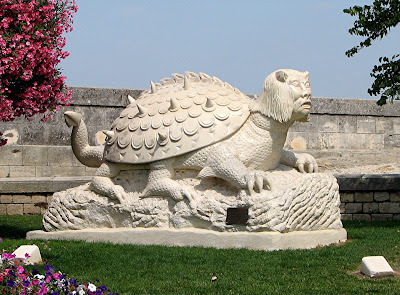 Tarasque sculpture near King René's castle in Tarascon; completed in 2005, it was created by Pascal Demaumont from a single block of marble weighing 25 tonnes!
Tarasque sculpture near King René's castle in Tarascon; completed in 2005, it was created by Pascal Demaumont from a single block of marble weighing 25 tonnes!Du Bois had heard terrifying rumours that a hideous creature called the tarasque had lately taken up residence along this stretch of the Rhône. Here it held in thrall the hapless populace of nearby Nerluc, a once-tranquil rural town whose inhabitants and livestock were now the focus of its relentless depredations. But it also devoured any wayfarer unfortunate enough to be passing this way and unwary enough not to sense the monster's proximity.
Distracted by these grisly thoughts flowing unchecked through his mind, the traveller fatally ignored a deep thunder-like rumble emanating from a shadowy glade just ahead. Suddenly, the glade seemed to erupt - disgorging from its hidden bowels a macabre vision spawned from the darkest of nightmares.
 Tarasque ornament
Tarasque ornamentLarger in size than the biggest horse or burliest ox, the tarasque stood on six powerful limbs equipped with the murderous paws of a giant bear, and furiously switched its long viperine tail from side to side like living whipcord. The magnificent mane of its leonine head flowed as a burnished sea of molten gold around its shoulders, and its teeth were great ivory daggers of death. Most extraordinary of all, however, was the massive carapace encrusting its back. Resembling the shell of a colossal tortoise, it bristled with an armoury of mighty spikes, rendering the monster invincible to any form of attack.
It was for good reason, therefore, that the ill-fated Jacques du Bois knew his life to be at an end - an end so swift that he did not even have time to scream. As he gazed motionless at his destroyer, like a songbird mesmerised by the hypnotic stare of a serpent, the tarasque opened its fearsome maw and let out a deafening roar - accompanied by a stream of blazing fire that curled around its luckless victim and ignited his flesh like tinder.
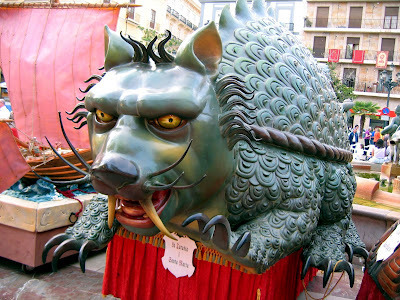 Life-size tarasque model at a Corpus Christi procession in Valencia (Chosovi-Wikipedia)
Life-size tarasque model at a Corpus Christi procession in Valencia (Chosovi-Wikipedia)As time went by, the inhabitants of Nerluc grew ever more desperate to free themselves from the tarasque's unremitting tyranny. One one occasion, 16 of the town's bravest men marched out to do battle with their adversary - but all to no avail. In a matter of moments, half of their number had been incinerated by a single blast of flame belched from the monster's gullet, and the remaining octet fled back to Nerluc, fortunate to have survived their ordeal by fire.
Nerluc seemed doomed, destined for destruction - but then there came along someone who may well have seemed, at least to an outsider, to be the most unlikely dragon vanquisher of all time. One day, a small boat docked at the nearby port of Saintes-Maries-de-la-Mer, and out of it stepped a young, lissom maiden, with fresh complexion and a simple dress of purest white. She had journeyed here from Arles, from where her fame had spread far and wide. For this unassuming figure of gentle demeanour was Saint Martha - whose inspirational preaching and acts of selfless beneficence had brought joy and hope to all who met her.
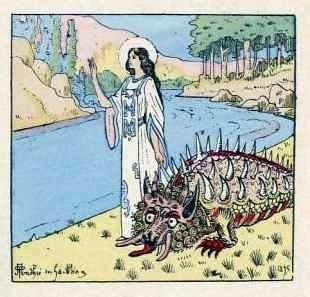 St Martha and the tarasque - an exquisite illustration from 1895
St Martha and the tarasque - an exquisite illustration from 1895As soon as her arrival became known, the townspeople of Nerluc flocked to her and tearfully implored her to free them from the oppression of the tarasque. In reply, Saint Martha promised to do all she could for them, and, without further ado, she journeyed through the outlying fields towards the Rhône-bordering forest that harboured her fire-breathing quarry. She did not have to search for long. Within a few minutes of entering the forest's verdant interior, she spied the tarasque in a sunlit clearing - devouring the final portion of its latest victim, a local herdsman.
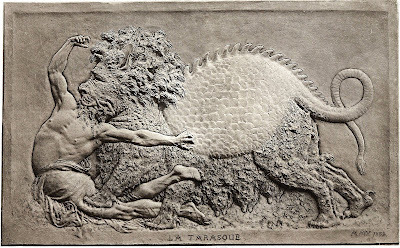 Tarasque bas-relief sculpture by Jean Barnabé Amy, 1880s
Tarasque bas-relief sculpture by Jean Barnabé Amy, 1880sSo intent was the monster upon its gory repast that it remained totally unaware of her presence. This enabled the saint to approach to within touching distance of its gleaming carapace and rippling mane - and also to pick up two branches that had been recently charred by its conflagrating breath. In that moment, however, the tarasque sensed her, and whirled around, its rapacious eyes ablaze with paroxysms of flame like febrile, dancing infernos.
Instantly, Martha raised the two branches in front of her, and held them before her monstrous adversary in the shape of the Cross. As she did so, the tarasque's eyes dimmed, their incandescence replaced by a mellow golden hue, and the mighty creature lay passively at the saint's feet, overcome by a welter of bemusement and unwonted peace. Martha bent down and sprinkled holy water all over the subdued dragon. Then with braids of her own hair she wove a huge collar and lead with which she led it amiably back to Nerluc.
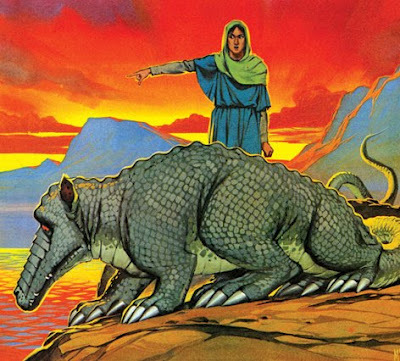 Looking decidedly abashed here, the tarasque is soundly chastised by a very stern-looking St Martha (Angus McBride)
Looking decidedly abashed here, the tarasque is soundly chastised by a very stern-looking St Martha (Angus McBride)This astonishing spectacle - the bloodthirsty tarasque, tethered and tame as a docile puppy! - initially rendered the townspeople speechless and immobile. Once their fear of their longstanding enemy had subsided, however, they grew bolder, coming up to the beast and touching it - then hitting, punching, and kicking it, and hurling rocks and sticks at it, as their anger at its former atrocities burst forth in an uncontrollable tide of hatred and revenge. The tarasque cowered in fright at this sustained onslaught, and Saint Martha pleaded with the horde to forgive the beast and let it live in its new, transformed state - but it was too late. Whether through direct physical attack or the almost tangible weight of loathing heaped upon it, the tarasque suddenly rolled over, and died.
 The 2011 tarasque parade at Tarascon
The 2011 tarasque parade at TarasconEven today, this monster's memory is still manifest here. As a lasting reminder of its former tribulations, Nerluc is nowadays called Tarascon, it stages a tarasque festival each Whitsun, and its official seal depicts this erstwhile oppressor in all its terrible splendour.
Due to its exceptional morphology, cryptozoologists rarely seek to identify the tarasque with any known type of animal, either from the present or from the past. Having said that, over the years I have encountered one or two brave attempts - in which this extraordinary neo-dragon has been variously mooted as a surviving ankylosaur dinosaur or a lingering glyptodont (gigantic armadillo-like mammal from prehistoric South America). Ingenious suggestions, certainly, but tragically flawed by the unavoidable fact that no ankylosaur or glyptodont unearthed so far by palaeontologists happens to possess six legs!
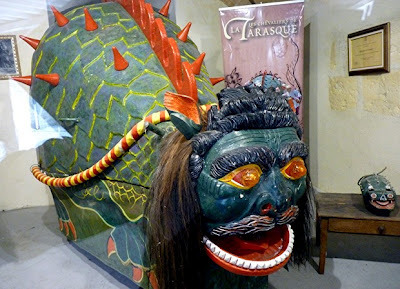 Life-size tarasque model at exhibition centre in Tarascon
Life-size tarasque model at exhibition centre in Tarascon
Published on March 04, 2012 01:49
February 27, 2012
WELCOME TO THE JOURNAL OF CRYPTOZOOLOGY - A NEW, PEER-REVIEWED SCIENTIFIC JOURNAL DEVOTED TO MYSTERY ANIMALS.

With the demise of Kraken and, in particular, Cryptozoology (published by the now-defunct International Society of Cryptozoology), there has been no peer-reviewed scientific journal devoted to cryptozoology for quite some time. Consequently, the Journal of Cryptozoology is launched today to remedy this situation and fill a notable gap in the literature of cryptids and their investigation. For although some mainstream zoological journals are beginning to show slightly less reluctance than before to publish papers with a cryptozoological theme, it is still by no means an easy task for such papers to gain acceptance, and, as a result, potentially significant, serious contributions to the subject are not receiving the scientific attention that they deserve. Now, however, they have a journal of their own once again, and one that adheres to the same high standards for publication as mainstream zoological periodicals.
To that end, a distinguished peer review panel has been assembled, currently numbering ten members in total* (although this may increase in the future), consisting of some of the world's most eminent zoologists and associated researchers in their respective fields. And I am honoured to have been invited by the journal's originator and publisher, CFZ Press, to become Editor - an invitation that I am delighted to accept.
It is planned that each volume of the Journal of Cryptozoology should contain at least four papers. These can be discussion or review articles concerning a given cryptozoological subject, research-related papers, or field reports. Details concerning the required presentation formats for these contributions can be found on the journal's inside back cover and are also included below.
Down through the decades, cryptozoology has been defined in different ways by different researchers, with some definitions much more restrictive than others. Consequently, it is important to make clear the definition – and therefore the scope of subjects available for papers – to which this journal adheres. For the purposes of relevance to this journal, a cryptid is a creature that is known to the local people sharing its domain (ethnoknown) but unrecognised by scientists. Such a creature may be any of the following:
1) A species or subspecies apparently unknown to science, including alleged prehistoric survivors (e.g. mokele-mbembe).
2) A species or subspecies presently unknown to science in the living state, but which is known to have existed in historical times and allegedly still persists today (e.g. thylacine).
3) A species or subspecies known to science but allegedly existing as a natural occurrence in a location outside its scientifically-recognised current geographical distribution (e.g. puma in the eastern USA).
4) A species or subspecies known to science but allegedly existing as an artificial occurrence (i.e. due to human intervention) in a location outside its scientifically-recognised geographical distribution (e.g. alien big cats in Britain).
5) An unrecognised non-taxonomic variant of a known species or subspecies (e.g. Fujian blue tiger; prior to its scientific recognition, the journal's logo creature, the king cheetah, was another example from this category).
In addition, papers dealing with fabulous, mythological beasts will be considered for publication in the journal if their subjects have direct relevance to cryptids (e.g. reviewing the similarity between a given lake monster from folklore and cryptids reported in that same lake in modern times).
Some cryptozoological researchers prefer to impose a lower size limit for cryptids, arguing that a crucial aspect of a cryptid's definition is that it should be of unexpected form. However, as I have revealed time and again in my various books documenting new and rediscovered animals, some very notable, unexpected cryptids were also very small. This is exemplified by Kitti's hog-nosed bat Craseonycteris thonglongyai, scientifically described in 1974 but already known to the local Thai people, and so dramatically different from all other bats that it required the creation of an entirely new taxonomic family to accommodate it – yet it is no bigger in size than a bumblebee. Consequently, although this journal is primarily interested with 'classic' cryptids, i.e. those of large or relatively large size, whose apparent continuing existence undiscovered by science is therefore particularly surprising, papers dealing with interesting, unusual, or potentially significant cryptids of smaller size will also be considered for publication.
Please note: unidentified animal-like (zooform) entities of an apparently paranormal nature, e.g. spectral Black Dogs, fall outside the scope of subjects with which this journal is concerned.
It is always exciting to be part of a major new development, and I believe that the Journal of Cryptozoology marks a major new development in the advancement and mainstream awareness of cryptozoology. I hope that you will too.
Consequently, I now wish to take this opportunity to make a formal call for papers for publication in the journal's inaugural volume, scheduled for publication later this year. Below are guidelines concerning requirements for the submission and presentation of manuscripts of papers to the Journal of Cryptozoology that must be adhered to by contributors.
All submissions must be original manuscripts not previously published elsewhere or submitted elsewhere simultaneously with submission to this journal. All submissions will be sent to two members of the journal's peer review panel for their opinions concerning content, clarity, and relevance to cryptozoology. Their comments will then be studied by the editor whose decision is final concerning whether or not the manuscript is published, subject if necessary to amendments by the author(s) if suggested by the reviewers. The copyright of all published papers belongs to this journal.
All manuscripts submitted should be one of the following three types of paper:
Discussion/Review article: Its subject should be a discussion or literature review of a given cryptozoological subject, and should not include original, unpublished research. It can be of 1000-3000 words in length, and can also include clearly labelled and numbered b/w photographs, artwork, tables, or maps, provided that the copyright of these falls into one of the following three categories:
(1) owned by the author(s);
(2) has been granted to them in writing by their copyright owner(s) - a copy of such permission will need to be submitted with the manuscript and artwork;
(3) expired, i.e. in the public domain.
The article should be preceded by a 200-word abstract, and should be divided into relevant subtitled sections. A reference list can be included at the end of the article; if so, this and the accompanying in-text citation style should correspond with the preferred version outlined below.
Research article: Its subject should be original research (but not fieldwork) conducted by the author(s). It should be of comparable length to or shorter than discussion/review articles, but with a minimum count of 1000 words. It can also include clearly labelled and numbered b/w photographs, artwork, tables, or maps, provided that the copyright of these falls into one of the three above-listed categories. The article should be preceded by a 100-word abstract, and its main text should be split into four sections – Introduction, Materials and Methods, Results, Discussion. A reference list can be included at the end of the article; if so, this and the accompanying in-text citation style should correspond with the preferred version outlined below.
Field report: Its subject should be fieldwork conducted by the author(s). It should be of 1000-2000 words in length. It can also include clearly labelled and numbered b/w photographs, artwork, tables, or maps, provided that the copyright of these falls into one of the three above-listed categories. The article should be preceded by a 100-word abstract, and its main text should be split into four sections – Introduction, Description (in which the fieldwork undertaken is described), Results, Discussion (which should also include details of any future plans). A reference list can be included at the end of the article; if so, this and the accompanying in-text citation style should correspond with the preferred version outlined below.
Style of reference citation required:
All in-text citations should be: author(s) surnames, comma, year of publication, all in parentheses. If the cited reference has more than two co-authors, give only the first surname followed by et al. Examples: (Jones, 1987), or (Jones & Jones, 1987), or (Jones et al., 1987).
For books, the style required for the reference list should be: Author surname followed by given names with first (or legal) given name in full and others as initials, followed by the year of publication in parentheses, and a full stop/period. The title of the book should be italicised, with its principal words beginning with a capital letter, and should end with a full stop/period. The publisher's name should then be given, with the town or city of publication included in parentheses. If the book is co-authored by two authors, their names should be separated by an ampersand; if co-authored by more than two, all but the last name should be separated by commas, and the last name should be separated by an ampersand. Here are some hypothetical examples:
Smith, John C. (1987). The History of Cryptozoology. Jones & Son (London).
Smith, John C. & Jones, James A. (1987). The History of Cryptozoology. Jones & Son (London).
Smith, John C., Taylor, Paul B., & Jones, James A. (1987). The History of Cryptozoology. Jones & Son (London).
For journal articles, the style required for the reference list should be: Author surname followed by given names with first (or legal) given name in full and others as initials, followed by the year of publication in parentheses, and a full stop/period. The title of the article should not be italicised, and should not be capitalised (other than the first word). The title of the journal should be given in full, not abbreviated, with its principal words beginning with a capital letter, it should be italicised, and should end with a comma. Volume numbers should be given as figures, issue numbers also as figures (preceded by no.) but included in parentheses following the volume number (together with date of issue if relevant, and separated from issue number by a semi-colon), followed by a colon, and then the page numbers, given in full. If the article is in a newspaper, the town or city of publication in parentheses should follow the newspaper's title, and instead of volume numbers, the full date of publication will suffice, followed by the page number(s) if known. Here are some hypothetical examples:
Smith, John C. (1987). Investigation of an unidentified lizard carcase discovered in Senegal. Journal of Lizard Studies, 33 (no. 2; September): 52-59.
Smith, John C. (1987). Mystery cat on the loose in Wales. Daily Exclusive (London), 4 February: 23.
For online sources, if an author name is given, it should be presented in the same style as for books and articles, followed by the title of the source, which should adhere to the style format given above for a hard-copy journal article, followed by the complete URL, date of posting if given, and the date upon which it was accessed by the paper's author(s). Here is an example:
Shuker, Karl P.N. (2012). Quest for the kondlo – Zululand's forgotten mystery bird. http://www.karlshuker.blogspot.com/20... 21 February. Accessed 24 February 2012.
If no author is given, simply begin the reference with - , then give the article title, etc as above.
I look forward to receiving and evaluating your submissions. Please email them to me at my usual address - karlshuker@aol.com
Dr Karl P.N. Shuker, the Editor, the Journal of Cryptozoology, 27 February 2012.
*The peer-review panel for the Journal of Cryptozoology:
Tom Gilbert
Colin Groves
Christine Janis
Paul LeBlond
Adrienne Mayer
Darren Naish
Charles Paxton
Brian Regal
Lars Thomas
David Waldron
Published on February 27, 2012 00:47
Karl Shuker's Blog
- Karl Shuker's profile
- 45 followers
Karl Shuker isn't a Goodreads Author
(yet),
but they
do have a blog,
so here are some recent posts imported from
their feed.



